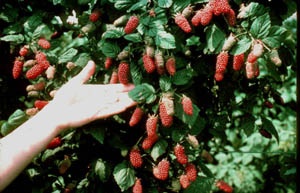Reading Derek Jennings’ article on raspberries on the main web-site I was reminded of all his fruit breeding successes: what a wonderful achievement! When Derek retired from the Scottish Crop Research Institute in Dundee some twenty years ago I suggested that he come down and work with us in Kent; he was much too young and full of ideas to stop working and the fruit industry needed his vision. He turned his attention to autumn fruiting raspberries and strawberries – Joan Squire and Joan J raspberries are the best known and the much publicised Chelsea Pensioner strawberry is one of Derek’s seedlings.
I used to grow Joan Squire raspberry as a commercial double crop in tunnels – one in the spring, beginning in late May, and another in the autumn. For the spring crop we thinned to eight canes per metre in the winter and allowed double the number of canes for the autumn crop. Thinning the canes exposed the fruit beautifully and it also made it much easier for the pickers. The old canes were tipped in March – cutting from 3-12 ins off – back to the new growth and they threw out plenty of fruit bearing laterals. Picking could go on from late May or early June until July, when the old canes were removed, leaving the new growth for the second crop; these canes were thinned in August. Taking a spring crop delayed the autumn crop by about a month and picking began again in late September, which was very useful as it meant the fruit came into a better price bracket. Also because these canes developed later they were more vegetative, making for a better spring crop. Joan Squire was an all round winner: a lovely sized raspberry, although it becomes smaller at the end of the season.
Now retired I grow my namesake, Brice, another of Derek’s seedlings, in a greenhouse and manage to pick raspberries from early June to November! As one cane finishes fruiting then I cut it out and bring on another.
Simon Brice
To read ‘Autumn Fruiting Raspberries; keeping up with the Joans’ go to
http://www.fruitforum.net/autumn-fruiting-raspberries-keeping-up-with-the-jo.htm




